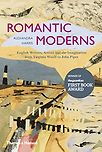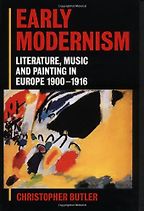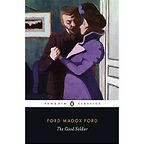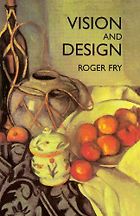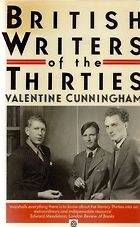Before we get to the books, what is modernism?
There’s no one answer to that. What we’re really talking about is a radical shift in the expectations of art in the late 19th and early 20th century – a great new self-consciousness about the processes of art and what it means to be an artist. Also, what it means be a reader or a viewer. There’s a new sense that you mustn’t just lose yourself in a narrative but think about how that narrative is formed and shaped, and who is talking to you. In a way, modernism exposes some of the clockwork of the makings of art – to me that’s one of the most fascinating things about it. It takes us behind the scenes and breaks apart all our assumptions about how art is made.
When you talk about art, you mean right across the arts?
Right across. It’s very much debated where modernism starts. Some people might call Flaubert a modernist. Other people talk about Henry James as a modernist. Joseph Conrad’s The Heart of Darkness was written in 1899 and you would have to call that a modernist novel. There’s a bubbling of ideas in the 1890s, so I suppose early modernism can be situated from about 1900 to 1914. The First World War really galvanised a whole new phase of radical writing and experiment. You can argue a modernist label for anything experimental in the early 20th century.
As you say, the First World War was pivotal in the development of modernist ideas as they came to represent a rejection of everything that had come before the carnage of the conflict.
This is true. But before 1914 you had small splinter groups like the Futurists, calling for a complete break with the past. I think what happened is that the war, and its effects on all of European society, brought to a whole new level of exposure this drive towards change – the urgency with which people were calling for a new world, a kind of utopian vision.
It’s very easy to paint it black and white and say that all modernists rejected the ideas of the past. But in your book Romantic Moderns you point out that many modernists actually had nostalgia for what came before.
That’s right. Any of the great modernists texts – such as James Joyce’s Ulysses, TS Eliot’s The Wasteland, Virginia Woolf’s To The Lighthouse – were built out of fragments of past styles, past literature, past traditions. So there is a link to the past with modernism, but there’s a new sense of how we view that past. In Romantic Moderns I try to show that right into the 1930s and 1940s there was a kind of a negotiation between experiment and tradition. All the headline catching goes on in the 1920s with the urge to make a new world. I try to look for the bridge between that urge to utopianism and the much more insular, traditional urge of the thirties and forties when European society closed in on itself with the build-up and outbreak of war. Each threatened country was asking itself what it stood for and you get a much more insular culture, whereas high modernism was very much internationalist.
Was British modernism different from the experience of continental Europe? Was it “modernism light”? British modernists did seem to retain a strong sense of love and nostalgia for the countryside, for example.
That might apply to the thirties and forties. But the great high modernists were largely British or Irish. Eliot, WB Yeats, Joyce, Woolf, DH Lawrence and Joseph Conrad are the great pillars of literary reform in the early 20th century. So the seat of high modernism was this side of the channel, although the visual arts and music were much more centred in Paris and Russia. The literariness of England as a nation really showed up in that mapping of modernism.
A need to reject the past and embrace the future is, I suppose, largely determined by one’s own experiences. For example, the Jews from the Bauhaus escaping Nazi Germany were particularly determined to forge a new future through design and architecture.
To an extent, yes. But take Nikolaus Pevsner for example, who was one of the great exponents of the Bauhaus version of modernism in England. Because there’s such a strong German tradition of minimal, pared down, internationalist architecture, for him it was a kind of nostalgia. It wasn’t our English tradition but a German tradition, so it seemed to us very brutal and modernist. But to him it was laden with associations and emotions, as it was for the other émigré artists like Laszlo Maholy-Nagy and Naum Gabo.
“You can argue a modernist label for anything experimental in the early 20th century”
Again, what seems very new is actually attached to a tradition, and is so much more interesting than an absolute break with the past. A lot of these buildings that seem very modern are deeply entangled with a tradition of classical architecture using the same classical symmetries and the sense of elegance and refinement that comes straight down from Greece and Rome, and it doesn’t get more traditional than that. So there’s always a traditionalism in the modern.
In the 1930s there almost seemed to be a backlash against modernism in Britain. The painter John Piper turned away from abstraction, and writers like John Betjeman criticised modern architecture.
What they really wanted was the flexibility. Modernist manifestos tended to be very uncompromising. You had to assert your creed, your vision of the world, and you’d carry it out in all your work. For somebody like Piper, whose interests were very wide and who wanted to look at abstract modern painting but also cycle down to the local church and take photographs, that kind of manifesto was very limiting for him, so he railed against category and labelling. He wanted to be able to be an abstract painter who also looked at fields, and that proved very controversial. What he fought for was a kind of eclecticism that I think has been the best of British ever since, but a hard won battle. Now artists are praised for constantly trying something new, and wanting to look at all kinds of different subject matter.
Can you tell us more about your first book choice?
This is partly a sentimental choice because Christopher Butler was my first tutor at university. I knew that I loved Virginia Woolf but I didn’t really know why. Nor did I have any clue about the artistic context from which she emerged. It was this book that showed me how it was possible to talk about art in a way which was quite alien to me then. We all grow up talking about novels in terms of what happens in them – plot and characters – but Early Modernism showed me how you talk about the form of a novel, the texture of a piece of music, or why it is that Matisse paints a room without perspective and how if you half close your eyes that flat canvas becomes a dance of forms. This book is very good for people looking for a language to describe that, and it’s also very liberating in its determination to talk in one breath about music, art and literature.
Butler shows how they are all interlinked.
Absolutely. Interdisciplinary studies are all the rage in academia at the moment but it wasn’t always that way. This is a really pioneering book in terms of showing how you can compare what goes on in a piece of music with what goes on on a canvas – which is not immediately obvious. You need to be given a little bit of help to see how things connect in that way. And there’s a wonderful geographical scope to it as well. My own work has been very British but Early Modernism swings off across Russia, Spain, Italy and France. It shows how very wide-reaching were those modernist changes, and how a conversation about art can go on across a thousand miles.
The art historian Kenneth Clark described Roger Fry as “incomparably the greatest influence on taste since [John] Ruskin”. Can you tell us more about him?
Even if you are primarily interested in modernist literature, I would recommend having a good read of Fry on art. He totally revolutionises the way of talking about a picture. He will shut out the content of the picture and make you see it in terms of forms, blocks, colours and design. Design is one of his key words. One of the jokes about him is that he will look at a crucifixion painting, point to the body of Christ and say “this important blue mass in the centre”. But it also means that a window is opened up onto this whole new realm of aesthetic experience. You start to ask: “What is the difference between looking at a butterfly and looking at a painting of a butterfly?” Fry makes you acknowledge that a painting of a butterfly does something different from the butterfly sitting there, and asks what is it that a painting can do that nothing else in the world can do? That’s a central question for anyone wondering what happens when you walk around the Tate gallery in London – why have patterns on two-dimensional canvases acquired such status in our culture? What is it that they do?
He attempts to describe art and why it matters in “Essay in Aesthetics” in this volume, which he wrote in 1909.
Yes, and what it does to our emotions. He’s intent on feeling his way into what happens in our bodies when we look at a picture – what is it that we feel. Most people writing about art in his period wrote like connoisseurs, trying to work out who influenced Michelangelo at a particular moment and giving good, dry, historical facts about a picture. Fry blurts out: “Yes, but why does it make you cry?” He shows you why, for example, a child’s instinct is to draw a human head with the eyes much larger than they should be in proportion, because eyes are important for communication. So he shows you why distortion beyond the photographic is meaningful, and why a brilliant painter will distort rather than simply represent what is in front of him.
This must have been quite radical when the book was published.
It was very different. If one thinks about late Victorian and early 20th century painting – lots of conventional, detailed, almost photographic social scenes – Fry caught hold of the great movement in France to post-impressionism. He invented the term “post-impressionism” and introduced to Britain French painters like Cezanne, Gauguin and Manet for the first time. That really was the beginning of modern art in Britain.
His book Vision and Design is a collection of 25 essays. Can you tell us more about them?
It starts off with manifesto essays, like his essay on aesthetics and his essay on art and socialism, which politicises the making of art. Part of his politics is a tremendous eclecticism – he’s willing to pay attention to the art of what was then thought of as primitive peoples. He writes essays on African sculpture and the art of the Bushmen. He looks at the art of cave paintings, showing how very early primitive people instinctively distorted the form of an animal but did so with far more intelligence than bourgeois Victorian artists who were simply replicating the look of an animal down to every hair on its head.
He really shifted the sense of what it is to be an intelligent artist. He famously draws attention to African and South American art, so there is a challenging of the European supremacy as well. That goes right across modernism – from Picasso looking at African masks to DH Lawrence talking about African sculpture – but Fry very seriously makes people in London think about South American forms and the dynamic of African sculptures.
Your next choice is a broad and critical account of British literature in the 1930s.
This is a treasure trove book. It’s enormous and probably best not to be read in one fell swoop – it’s a wonderful dipping book. What I love about it is how it gathers together a huge number of writers from the 1930s and shows that they are using similar kinds of imagery and behaviour. What fascinates me here is to do with fashion – to do with what holds a generation of people together. I’m very drawn to the mercurial and elusive sense of what makes a particular moment, and what makes something important in that moment. This book is a very brilliant form of literary criticism that shows you how certain ideas gather currency and become significant for particular milieux and generations.
The book is arranged thematically. You have, for example, a chapter on the movement of the masses which is full of ideas about people moving in mass – about the way people get about, and how the individual related to power and being a part of something big in the thirties. But you also have chapters on how certain people become the ring leaders. He begins with a chapter called Vin Rouge Ordinaire, which is about WH Auden as a vintage wine label of the thirties – how everything is a kind of response to Auden, either arguing with him or flattering him in some way. So it’s a book about how the mood of the times was made up, and how the texture of the literary culture came into being.
How did British literature of the thirties compare to that of the twenties and to what extent did the rise of fascism in Europe affect British literature?
I’ll answer the second question first. The Spanish Civil War was a great rallying call to the younger generation of literary and political people. If you were a young poet in the thirties, you had to take sides in the Spanish Civil War. There was a book called Writers Take Sides – you had to say what you thought of the war, and if you were going to intervene then you needed to get yourself to the front, which a great many writers did. You were defined in that period by having either military interventionist politics or various forms of passivism – that would go through to Munich and the Second World War itself.
The question keeps being asked, “What can art do in the face of political crisis?” Should artists and writers be responding directly to world affairs, should they be writing poetry about conflict, or should they give up their poetry and go to fight? Which a great many did. Or do you take the view – as Virginia Woolf did, partly – that it’s tremendously important in a society to have reasonably objective voices who are not implicated in a cause, who are not taking sides, who are producing a literature that stays outside the realm of propaganda. Which leads in to your first question about the difference between the literature of the thirties and the twenties. The difference is largely politics. The pressure to either intervene or step back from politics is so great that the whole artistic scene is defined by it in a way. In the face of violence and tragedy, what does the artist do? That is one of the great questions of the 1930s.
Does this book focus on the writing of the thirties or the writers themselves?
It’s about writers. Cunningham reads their whole lives as part of their art, which I find rather inspiring. Because [the poet] Julian Bell gets on the boat and drives ambulances in the Spanish Civil War, that is one of his artistic decisions of the period but it’s not a poem. There’s a way in which by writing about writers you include all that they do as part of the culture of the times. He writes about a culture, not just about what gets typed up on paper.
Tell us a little about Woolf, who was the subject of your own book. 70 years after her death, why are you and others still writing about her?
Her novels are timeless in many ways. A great deal of interpretation tries to put us back into the historical context of those novels, which is tremendously important. There is also the way in which they have a universal significance as novels. I was shocked when I was first read her that it was possible to write a novel [To The Lighthouse] about a little boy going to a lighthouse and for that to be the central plot. Nothing else really happens at all yet it left me absolutely reeling, with a sense that I needed to reorder my life and that life was now going to be a different experience.
What she does is all to do with style, form, structure and symbolism. It’s very much not to do with plot. That was one of the great mysteries that I wanted to keep getting at, and which sent me back to read more. Another thing I tried to emphasise in my book on Woolf was her capacity for enjoyment of all kinds of things in the world. She’s often portrayed as a very exquisite and withdrawn figure who was liable to have nervous breakdowns at any moment. But what strikes me most about her novels, diaries and letters is her garrulousness, her gossipyness – her relentless capacity for living and looking at the world.
She was certainly relentless in her opinions. Do you think you would have liked her if you had met her?
I would have been absolutely terrified to meet her, but I would have been absolutely seduced if what comes out on her paper in her novels came out of her mouth at me. I would be just bewitched by the speed of her figurative language, the precision with which she captures people, a street, the setting of the sun, the kind of wind. It’s so extraordinary.
There’s a lovely quote from the British writer Victoria Glendinning on Woolf: “No additional book about her is strictly necessary, but then neither is chocolate.”
I agree wholesale. Woolf was able to tell the same story 50 times without repeating herself. She will report the same anecdote to three friends in different letters and never use the same word twice. That limitless exercise in reformulating the world – in seeing how life is so very multi-faceted – is an inspiration for the people who came after her to keep talking about her work.
Of all her novels why did you choose her third, Jacob’s Room?
This was really her first experimental novel. We have a hero, Jacob, at the centre of the book who keeps going missing. When the book starts, Jacob is a little boy on the beach – he’s run off and we have to go find him. Then we chase him through his life, but we really never get to sit down and talk to him as you would in a Victorian novel where you would look at every facet of a character. We see him disappearing on the back of an omnibus and the narrator takes us to his student room in Cambridge, but he’s gone to dinner and he’s not there. So we look around and see the invitation cards on his mantelpiece, the books on his table and his empty chair.
It’s a great test of how far we get to know the people in our lives. What can we tell about them just from meeting them for a moment? What can we tell from going into their room? How much of a mark do people leave on the world? What is a room like when they go out of it? These are questions which in a way are ordinary, because we all experience someone going out of a room, someone leaving a house. But we don’t think about it very much. We don’t think how well we know our friends, or how well we know members of our family. In this book, Woolf makes the subject matter not Jacob himself but the ways in which we know and don’t know each other – the gaps in our knowledge. It’s a very ghostly book in that we have a very likeable hero and want to get to know him a lot, but he keeps disappearing. At the end his surname, Flanders, comes into its own and he dies in the First World War.
Get the weekly Five Books newsletter
Woolf captures this sense of an upper middle class young man with certain expectations in life, all the stereotypical things that he is likely to do – go to university, go on boating trips with his friends, or trips to the British Library. She looks for the social panoply around him. She pays attention to the old woman who’s sweeping up around the statues at Westminster, or the guards at night who shine their torches around the British Museum library when the posh people have gone home. She looks into the corners of life and what these dusty corners tell us about the central subject – as we can’t look at anyone straight in the face, we have to be detectives and nose around.
The book is seen as an important modernist text. It is a departure from the traditional novel, isn’t it?
No novel sets out to be traditional. People often hold up Dickens or George Eliot as “the traditional novelists”, but the moment you think about what Dickens is doing, you realise he is wildly experimental in creating his characters. So one has to be careful about condemning everything that came before modernism as stuck in the mud. But certainly Woolf does something new, which is to present us with very short chapters, each of which is a little glimpse, a little shard of experience. She doesn’t bother taking the reader by the hand and carrying us between chapters. She just leaves a space on the page and we have to catch up with Jacob in the next chapter. Maybe he’s 10 years older, but we have to keep up. The sense that life is not delivered to us fully narrated on a plate, but rather that we spend our lives piecing together bits of evidence, is partly what was so new about the book.
Your final book is a novel with a memorable opening line: “This is the saddest story I have ever heard.” Will you tell us more about it?
It really is a sad story, about four people – two couples – who are at a German spa resort and dance what Ford calls a “four square minuet”. They are a kind of microcosm of the upper middle class social scene in Europe before the First World War, and it falls apart. There are various affairs, splittings, attractions, secrets and lies between them. One of the great tag lines of the book is that it describes “just good people”. It turns out that these are not just good people. They are people who from the outside are respectable and pillars of society. But on the inside they are seething, raging and in love with the wrong people.
It’s narrated by one of these four people – John Dowell, an American. He’s the archetypal unreliable narrator in that he hasn’t understood what’s been going on and he doesn’t understand that his wife is in love with another man. A great deal has passed him by, and the book is really his attempt to narrate his own story. So, as with Jacob’s Room, it’s about what is missing from a story – about everything that is not known. John Dowell says over and over again, “I don’t know”. He’s writing this story in an attempt to understand what has happened but sometimes he just has to say “I don’t know”.
That is one of the great modernist admissions. It’s the movement away from omnipotent, omniscient narrators who can tell you exactly what’s what to narrators like John Dowell, who is very fallible, quite unlikeable and simply tells you what he experienced and what he can understand in retrospect about what happened. He also tells the story in a very roundabout way, which is another great departure from the logical chronology of earlier novels. The story is almost a maze. It’s not a straight line narrative at all. Again, this is about exposing the problems of art. Ford shows us the clockwork of a story, how a story is made and that there is no authoritative version. Nobody experiences the authoritative version of events. All we have are partial, flaunted, half-invented versions of experience.
Five Books aims to keep its book recommendations and interviews up to date. If you are the interviewee and would like to update your choice of books (or even just what you say about them) please email us at [email protected]
Five Books interviews are expensive to produce. If you've enjoyed this interview, please support us by donating a small amount.

